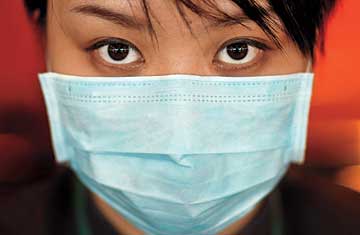
Where H1N1 spread, masks followed in an effort to stem the new flu virus.
It's fitting that in a booming metropolis of 20 million people, the first sign that Mexico City had been recalled to life wasn't a public religious ceremony or a political rally but a traffic jam. After a weeklong shutdown in response to the H1N1 flu outbreak, on May 5--Cinco de Mayo--Mexico City began to stir again. The spread of the swine flu had slowed, leading Mexican officials to hope that the worst had passed. "Our strategy is working," said Mexican President Felipe Calderón. "We are now in a position to gradually resume our everyday activities."
International health officials who had been on high alert since reports of a new influenza virus first surfaced in late April had also begun to relax--just a bit. Scientists at the World Health Organization (WHO) and the Centers for Disease Control and Prevention (CDC) found few serious or deadly cases outside Mexico and little evidence of sustained spread of the disease in most countries. Though by May 6 the virus had infected 1,516 people in 22 countries--including 642 in the U.S., where two people have died from it--and the world was still officially on the brink of a pandemic, the mood had cooled considerably at CDC headquarters in Atlanta. "We're not out of the woods," said Dr. Richard Besser, the CDC's acting director, but "we are seeing a lot of encouraging signs."
So, were the hundreds of U.S. school closures and the presidential press conferences about hand-washing much ado about not that much? Unfortunately not. As health officials pointed out repeatedly, we're still in the early days of the H1N1 outbreak, and influenza viruses are notoriously unpredictable. Right now the new disease seems to be no more dangerous than the seasonal flu (researchers who have examined the genetic code of the H1N1 virus say it appears to lack key mutations that made past pandemic-causing viruses so deadly), but H1N1 could return next winter in a more lethal form--just as the virus that caused the catastrophic 1918 pandemic did. "This is a situation that can evolve," said Dr. Keiji Fukuda, the WHO's interim assistant director-general for health, security and the environment. "If it does turn severe, this is something we have to jump on."
The reality is that while health officials in the U.S. and the rest of the world deserve praise for their comprehensive response to the new flu virus, H1N1 wasn't a true test of our mettle but a warning shot. "We should look at this as a wake-up call, not one more snooze alarm," says Dr. Irwin Redlener, the director of the National Center for Disaster Preparedness at Columbia University.
H1N1 makes clear how vulnerable our interconnected globe is to emerging diseases. As a result of jet travel and international trade, a new pathogen managed to seed itself in more than 20 countries in less than two weeks. But while globalization has its liabilities, it is also a strength because it gives us the tools to create a truly international disease-surveillance system. And the threat of a pandemic should remind us that we must fill the gaps in the creaky U.S. health-care system; during an infectious-disease outbreak, everyone will be at risk. "We live in one world, with one health," says Dr. Juan Lubroth, a senior officer at the U.N.'s Food and Agriculture Organization.
A Viral Early-Warning System
